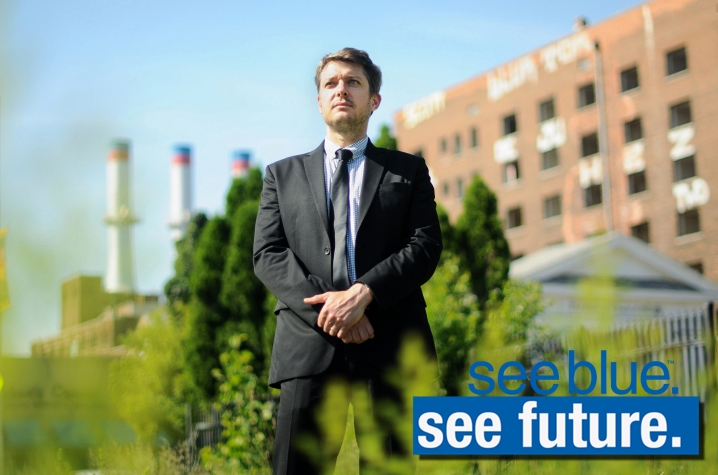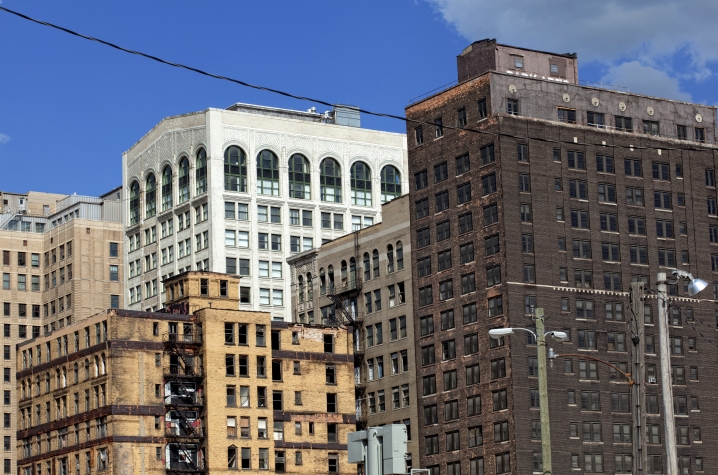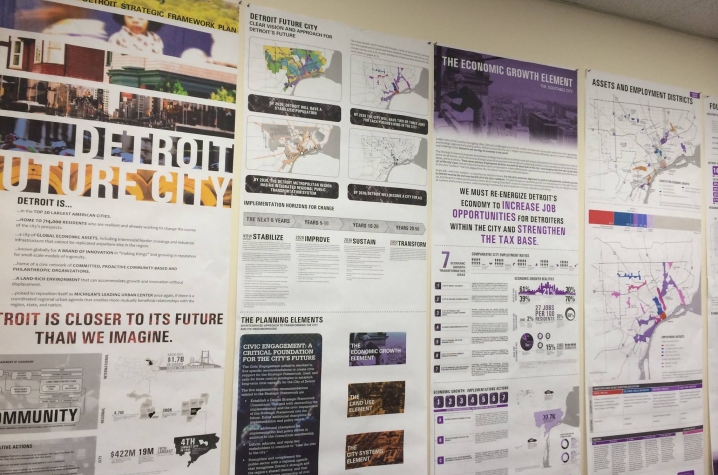UK Alumnus Designs Detroit's Future
LEXINGTON, Ky. (May 6, 2014) — If you've read much about Detroit in the news lately, it hasn't been good. Facing $18 billion in debt, Detroit declared Chapter 9 bankruptcy last July, becoming the largest U.S. city ever to do so. Its population, having dwindled from a 1950s peak of 1.86 million, is now just 700,000. Roughly half of Detroit's residents aged 25-64 are unemployed. Its violent crime rate is one of the worst in the nation. Approximately 20 square miles of land within the city — roughly the size of Manhattan — sit empty, where abandoned and blighted buildings have been leveled. An estimated 80,000 abandoned buildings remain in pockets scattered across the city's 138 square miles.
To some, Detroit's challenges might seem hopeless, but not to Dan Kinkead, a 1997 architecture graduate of the University of Kentucky College of Design and native Detroiter. Last April, Kinkead was named director of Detroit Future City (DFC), a comprehensive, forward-looking, city-wide strategic plan charged with, in Kinkead's words, "transforming Detroit's current liabilities into future assets."
Transforming a city
Before his appointment at DFC, Kinkead — who followed his architecture degree at UK with a master's in architecture and urban design at Harvard University in 2002 — had made a career of designing innovative buildings like Wells Hall, a new language arts building at Michigan State University, which he had to situate, per the university's request, atop an older, already existing building on campus.
Just out of Harvard, while working as an urban design leader at the New York-based offices of renowned architecture firm Skidmore, Owings and Merrill, Kinkead helped develop a master plan for Columbia University's expansion and redevelopment of an unused, former industrial section of West Harlem, among other projects in the United States, Europe and China.
As design principal at Detroit-based Hamilton Anderson Associates, Kinkead helped oversee the three-year-long development of the 350-page strategic framework that would become the basis of the "50-year land-use vision" at the heart of the DFC initiative.
"My whole education and career have been driven to understand what my clients are looking for and to find ways to translate their intrinsic objectives into something efficient and beautiful," Kinkead says. "In many ways, my work at DFC is no different. But the stakes are much higher. This is by far the most challenging thing I've ever done. This isn't about creating an individual building or an individual design. We're trying to fundamentally transform a major American city."
The DFC plan is multi-faceted, with goals to increase jobs and city safety, reduce blight, leverage the city's role as an inland port and logistics hub, develop neighborhoods that include capacity for food and clean-energy production, and transform unused land into city greenways and waterways.
"In Detroit, we have to move away from business as usual. But that's what is really exciting for us," Kinkead says. "I believe Detroit can be a leader in urban innovation, a model for how design, strategy and policy can impact legacy issues of older, industrialized cities."
Finding his calling
Growing up in Detroit, Kinkead knew he wanted to travel outside Michigan to attend college.
UK appealed to him because both his parents are alums, and he had spent his childhood summers around Kentucky's Rough River Lake.
While he'd always been a creative-minded child, forever drawing and building things, it wasn’t until driving from Detroit to UK for a planned college visit that Kinkead even considered architecture as a career.
"My dad and I were in the car, and I was flipping through UK's course catalog, those big blue books that they used to issue. I found the architecture listings and really got excited," he says. Kinkead set up a department visit and within five minutes of walking into Pence Hall, he knew he'd found his college home.
"We were greeted by professors Clyde Carpenter and Stephen Degar, and I saw all these models and drawings. They were building a structure that was sort of creeping out of one room and into the corridor," Kinkead says. "I knew right then and there that this was what I wanted to do."
Over the course of Kinkead's UK education, he had "many influential moments and a host of exceptional professors," he says. But two experiences stand out.
First, the opportunity to take part in the department's study abroad program in Venice, Italy, in spring 1995 under the tutelage of Maria Dallerba-Ricci was "transformative," Kinkead says. My studies came into sharp focus that semester, I formed a very tight bond with my classmates, and I came out of that experience a very different person."
Second, Kinkead's studies and subsequent teaching assistantship under UK faculty member Wallis Miller, who taught a course on the history and theory of modern architecture helped him understand how "context influences our work as architects, and how design can influence history itself," he says.
When Miller pegged Kinkead to be her teaching assistant, he says he felt it was the first moment someone saw something in him that was worthy of being elevated. "It was a foundational moment for me, and it gave me the confidence that I could do this work," says Kinkead.
"I want everyone to know what an incredibly strong program UK has. It's challenging, and has always celebrated creative curiosity and rigorous analysis," he says.
Measuring success
For Kinkead, helping Detroit realize a brighter future isn't just an academic or professional pursuit; it's also personal. Detroit is his hometown. It's where he and his wife are raising their children. They have a two-year-old daughter and are expecting twins this month.
"People ask me all the time, 'How will you know if you've succeeded with the DFC initiatives?'" Kinkead says. "That's a really difficult question. But what I can say is that, as a father, I focus on trying to make sure that this city is a place where my children can thrive as children and as adults. That it's a place where they can have a high quality of life and explore all the things they want to do. In many instances today, Detroiters struggle to realize that moment of success. So getting us there is a big thing for me. It's what keeps me going."
Feature on Dan Kinkead reprinted from Kentucky Alumni magazine's spring 2014 issue, "Dan Kinkead: Designing Detroit's Future" by Robin Roenker.
MEDIA CONTACT: Whitney Hale, 859-257-8716; whitney.hale@uky.edu







